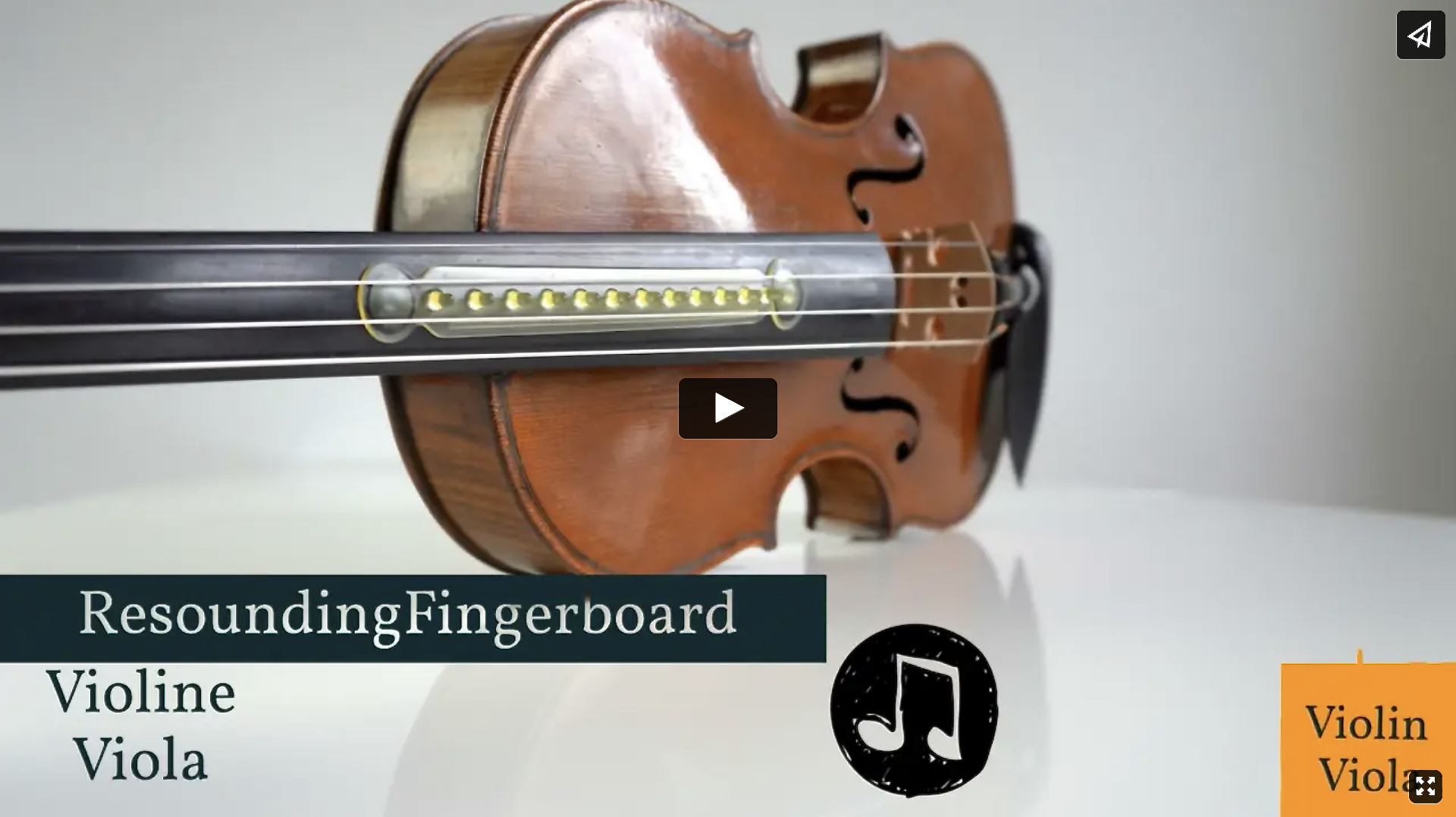ResoundingFingerboard
The first fingerboard attachment for strings
The ResoundingFingerboard is a fingerboard attachment designed for >>violin, viola<<, >>cello and double bass<< players of all levels. It can be used to learn and improve important technical aspects of instrumental playing, such as vibrato, trills or the double finger technique, in an innovative and effective way. This has some highly beneficial side effects: The finger speed becomes faster, the finger fall becomes more precise, and the intonation cleaner. The user will quickly develop an ideal balance between the stability and flexibility required in the fingers and find it easier to vary their newly developed sound spectrum. On top of all this, the ResoundingFingerboard allows the user to achieve better results in less time, while enjoying a more relaxed style of playing at the same time.
The ResoundingFingerboard enables:
- More pronounced and relaxed VIBRATO
- Faster and more even TRILLS
- A more precise and accurate DOUBLE GRIP TECHNIQUE
- A more refined and precise FINGER DROP
- Faster FINGER SPEED
- Clearer INTONATION
- A more sonorous LEFT HAND PIZZICATO technique
- A new SOUND SPECTRUM
- The perfect BALANCE between STABILITY and FLEXIBILITY
- Preventively, HEALTHIER and MORE RELAXED music making
Attaching the ResoundingFingerboard is easy. Within a few seconds you can attach it and start using it right away. What you do then depends on what you intend to do with him at all. You have several options: you can just do griffs or just do the movements of vibrato but you can also use him for specially developed exercises for topics like rhythm, coordination, trills, vibrato, arm vibrato, finger speed ...: It is clear that the fingerboard attachment is not made for just one thing.
Good news
The good news is: No matter what you focus on it has always positive side effects on at least your
- finger drop,
- finger speed,
- balance between stability and flexibility and
- healthier and more relaxed music making.
The right position on your fingerboard results from several aspects: 1) requirements due to the shape of your instrument, 2) from what you want to practice (left hand) and 3) if you want to add exercises with your bow or not.
Structural matters
The closer the fingerboard attachment is positioned towards the bridge, the greater is the distance between the strings and the fingerboard so that the strings have more space for vibration/swinging. Even on 3/4 and 1/2 sized instruments, you can attach the ResoundingFingerboard in a way that one string can swing freely. Alternative: So far we know of one violinist in whom no open string could simply swing freely. He positions it differently, between the first/second or third/fourth instead of in between the second/third string. In this case, the suction cups can also be attached. Due to the greater distance to the fourth or first string, he achieves a freely swinging string which enables him to use the fingerboard attachment in its full extent.
Left hand technique: without the bow
Depending on the structural matter, you can move the fingerboard attachment closer to the scroll for exercises which are designed for you rieft Hand technique without using the bow. Carefully pinch it under the strings on the hight of the second/third position. Caution: It is a flexible material and you should not damage it in the process.
Exercises with the bow
As soon as the bow is to be used at the same time, you need a little more space for swinging at least one open string.
There are times, in which nothing works out. This refers e.g. to the adherence of the suction cups on your fingerboard. Unten finden Sie erste Anregungen. You will find initial suggestions below.
There is a connection between a) the cleanliness of the fingerboard and how well it adheres to fingerboard and zwischen b) between the humidity and the adherence.
a) The cleaner and the more even the attachment is, the better is the adherence. >>Regular cleaning<< is there fore a matter of course. As well the proximity to the rosin dust as the contact with your hands (hand sweat) avoid the perfect fit on your instrument.
- Clean your fingerboard
- Clean your fingerboard attachment (Luke warm water, mild hand soap, avoid any aggressive detergents
etc.)
b) The doof news in advance: With an an instrument, stored in optimal humidity, the adhesion is generally very good. Since an instrument generally sounds better with optimal humidity, this is a clear win-win situation. Air that is too dry makes the suction cups more difficult to adhere to the wood. If everything has been done correctly regarding to cleanliness, checking the humidity would be a worthwhile option.
Nothing helps?
If none of that works, we recommend moistening the suction cups with a little water. Our experience is: It should not be too wet. It's all about some moisture. In the event that everything does not work, there is a solution >>Bad-Fingerboard-Day-Solution<<.
Learn more
Check this two causes if the your attachment wobbles: a)The attachment has not been stretched the perfect way b)The movements you do while using it aren't of fine motor skills.
a) Material and the shape of the ResoundingFingerboard allow to stretch the attachment carefully, right before you press down the suction cups. It is important not to overstretch it! In that case: attach the ResoundingFingerboard again. Before pressing down the second suction cups, carefully stretch it a little.
b) The attachment is designed to untighten if the user performs heavy-handed or if the movements are not performed with the needed balance between flexibility and stability. This enables the user to observe their developments at the moment of performing. Start with slow movements.








